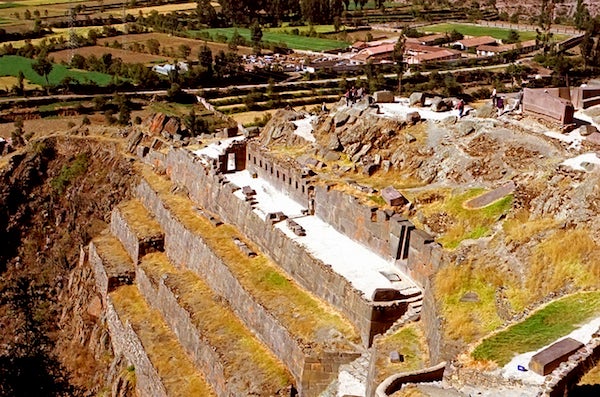This article was published in Scientific American’s former blog network and reflects the views of the author, not necessarily those of Scientific American
When I walked off the plane in Cuzco, Peru, en route to the Sacred Valley of the Incan Empire, I didn’t realize I would be entering one of the most culturally rich societies in the history of the world. You wouldn’t know it by the scene immediately outside of the airport: it looked like any other developing nation, with small, rundown buildings and battered cars clogging up pedestrian-lined roads.
Three hours away, however, lay the ruins of a civilization that had been astonishingly sophisticated before European Conquistadors arrived in the 16th century to destroy it. My preconceived notion, based on what I’d learned in school, was that the Quechuan people (the commoners of the Incan Empire) were no more than highly skilled builders in stone. But as a guide explained the logic of the Pisac Sun Temple to me, I began to understand how wrong I’d been. They were extraordinary builders, yes, but the structures they built also incorporated their deep knowledge of the heavens.
The Sun Temple sits atop a series of stone terraces—huge step-like earthen structures, built for farming purposes and kept in place by stone walls to keep them from washing down the mountainside. Once you climb them (which is more difficult than you’d expect, thanks to an elevation of almost 3,000 meters where the air doesn’t have much oxygen), you arrive at what looks like little more than a series of stone piles.
On supporting science journalism
If you're enjoying this article, consider supporting our award-winning journalism by subscribing. By purchasing a subscription you are helping to ensure the future of impactful stories about the discoveries and ideas shaping our world today.
In reality, they are so much more. The Inca—the supreme ruler of the empire—specifically created this structure to signal to his people when the seasons changed, so they’d know when to plant, harvest, and store. When the sun hits a particular large, white stone, the winter solstice has arrived. When it shines through the twin peaks of a neighboring mountain that vaguely resembles a condor (a sacred animal for the Quechuan people, representing the journey to the afterlife), it is the fall equinox, or harvesting time. When it hits the other side of the white stone, it is the summer solstice—time to plant. And in such a manner, what appears to be an arbitrary structure of rocks actually becomes the Sun Temple, the device by which the Inca were able to pace their planting seasons and provide food for an entire population.

The Sun Temple: terraces on the side were used for agriculture, but the rock pile on top is actually a sophisticated observatory. Credit: Dennis Jarvis Flickr (CC BY-SA 2.0)
For many years, scientists were unconvinced that the Sun Temple and other structures throughout the empire were especially accurate. But in 2013, a Polish-Peruvian research team, led by Mariusz Ziolkowski of University of Warsaw, Jacek Kościuk of Wroclaw University of Technology, and Fernando Astete, regional director of Machu Picchu published a study in the journal Anthropological Notebooks that proved otherwise. Using a 3D laser-scanning technique, the team tested the predictive power of Intimachay, a site at Machu Picchu. Intimachay resembles a cave of sorts, hidden under towering piles of stone, which has windows located on all four sides that let in sunlight during specific times of the year.
Previous researchers had discovered, for example, that sunlight entered the back wall of Intimachay through the Eastern Window ten days before and after the winter solstice, suggesting an astronomical connection. But this research was deemed inconclusive. But with their more sophisticated technology, Ziolkowski, Koscuik, and Astete confirmed their predecessors’ conclusion that parts of Machu Picchu were used as astronomical observatories.
Other parts of Intimachay, divided into sections named after the four cardinal directions, could also be used to identify the summer solstice and autumn and spring equinoxes. For example, the scientists found that during the summer solstice, the beams of the rising sun would enter Intimachay through the Northern Window and light up the tunnel wall. In the words of Ziolkowski and his colleagues, these discoveries proved that the Incas’ ability to track the seasons were “far more complex and precise than was previously believed.”
These season markers were far more important to the Inca than we can imagine. Although they lacked telescopes, clocks or any sort of modern technology, they knew enough to build structures that told an entire empire of twelve million people when to farm, to harvest, to shelter crops from coming rains, to hold religious celebrations, and so much more. It’s no exaggeration to say that without Intimachay and other buildings throughout the empire the mountain farming that sustained their people would have been significantly less reliable—a crucial factor that potentially could have stymied the growth of the empire.
So you can see that when I walked off that plane thinking that the Inca civilization was just another group of ancient people with little more than impressive construction skills, I was far from the truth. Standing atop Machu Picchu, I was looking at the work of people who were remarkable astronomers as well.